|
|
|
| My Favourite Planet > English > People > Alkamenes |
|
| |
Alkamenes
Alkamenes (Greek, Αλκαμένη; Latin, Alcamenes) was a Greek sculptor from Athens, working in the second half of the 5th century BC. Very little is known of his life. Pliny the Elder wrote that he was working at the time of the 83rd Olympiad (448-445 BC), in the same period as Pheidias, Critias (Kritios), Nesiotes and Hegias (Natural history, Book 34, chapter 19), and that he was an Athenian (Natural history, Book 36, chapter 4).
However, it is now considered that he and Pheidias were working around a generation later than the other three. According to the Suda (Ἀλκαμένης, Adler number: alpha 1269) he was from Lemnos (Λῆμνος). The northern Aegean island was an Athenian cleruchy or colony [1], and thus he may have been an Athenian citizen. A more recent theory is that the text should read Αίμνιος (Aimnios), and that he came from the Attic district of Amnai (Αίμναι).
He was a pupil of Pheidias at the same time as Agorakritos of Paros.
"Alcamenes, who was a pupil of Phidias, worked in marble and executed a Pentathlete in brass, known as the 'Encrinomenos' [highly approved]."
Pliny, Natural history, Book 34, chapter 19. At Perseus Digital Library.
"A thing, however, that is universally admitted, is the fact that he [Pheidias] was the instructor of Alcamenes, the Athenian, one of the most famous among the sculptors."
Pliny, Natural history, Book 36, chapter 4. At Perseus Digital Library.
Most of the works by Alkamenes mentioned by ancient authors were statues of deities, and like Pheidias he worked in bronze, marble and chryselephantine (sheets of gold and moulded ivory attached to a wooden framework).
His statue of Aphrodite in the Garden (ἄγαλμα τῆς Ἀφροδίτης τῆς ἐν τοῖς Κήποις), named after the Garden of Aphrodite near the Temple of Aphrodite Ourania (Οὐρανίαν Ἀφροδίτην, Heavenly Aphrodite), outside the city walls of Athens, was considered to be his most beautiful work. "Few things at Athens," wrote Pausanias, "are so well worth seeing as this".
"Concerning the district called The Gardens, and the temple of Aphrodite, there is no story that is told by them, nor yet about the Aphrodite which stands near the temple. Now the shape of it is square, like that of the Hermae, and the inscription declares that the Heavenly Aphrodite is the oldest of those called Fates. But the statue of Aphrodite in the Gardens is the work of Alcamenes, and one of the most note worthy things in Athens."
Pausanias, Description of Greece, Book 1, chapter 19, section 2. At Perseus Digital Library.
The statue was also mentioned by Pliny the Elder and Lucian of Samosata (Λουκιανός ὁ Σαμοσατεύς, circa 125-180 AD).
"A thing, however, that is universally admitted, is the fact that he [Pheidias] was the instructor of Alcamenes, the Athenian, one of the most famous among the sculptors. By this last artist, there are numerous statues in the temples at Athens; as also, without the walls there, the celebrated Venus, known as the Ἀφροδίτη ἐν κήποις [Aphrodite in the Garden], a work to which Phidias himself, it is said, put the finishing hand."
Pliny the Elder, Natural history, Book 36, chapter 4. At Perseus Digital Library.
"Lycinus: You have seen the Cnidian Aphrodite [by Praxiteles], anyhow; now I want to know whether you have also seen our own Aphrodite of the Gardens – the Alcamenes.
Polystratus: I must be a dullard of dullards, if that most exquisite of Alcamenes’s works had escaped my notice."
Lucian, A Portrait-Study. In: The Works of Lucian of Samosata. ebooks at the University of Adelaide.
Pliny the Elder ( Natural history, Book 36, chapter 4) also wrote that Alkamenes and Agorakritos of Paros, another pupil of Pheidias each entered a statue of Aphrodite in a contest, which Agorakritos won (see Agorakritos of Paros).
Alkamenes also made a bronze statue of Hephaistos, probably for the Hephaisteion, Athens (Cicero, de natura Deorum, 1.30, 83; Valerius Maximus, 8.11, ext. 3).
A marble statue of Hephaistos in the Ostia Archaeological Museum ( see photo below) is thought to be a Roman period copy of a work by Alkamenes.
A marble relief in Naples, depicting Hermes, Eurydice and Orpheus in the Underworld ( see photo below), is thought to be a 1st century AD copy of a Greek original of the second half of the 5th century BC, attributed to Alkamenes. |
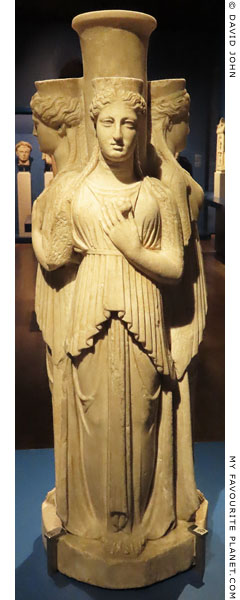
Marble statuette of Hekate
Triformis, perhaps inspired
by a work of Alkamenes
(see details below).
Roman period, 50-100 AD,
"after an original by Alcamenes,
430-420 BC". From Italy.
Height 75.5 cm, diameter 24.5 cm.
Rijksmuseum van Oudheden,
Leiden, Netherlands.
Inv. No. Pb 136.
From the collection of Peter Paul
Rubens; bequest of Gerard van
Papenbroek (1673-1743).
Three Archaistic female figures, shown frontally, stand around an irregularly shaped plinth, leaning their backs on a simple column in the centre. Each wears a polos and a peplos, girdled above the waist, over a long chiton. Two figures hold a pomegranate in the left hand, placed on the breast. The third held a torch.
It is not known how or when Rubens acquired the work. A self-portrait, now in the Hermitage, Saint Petersburg, shows him with his son and the statuette in the background. |
|
| |
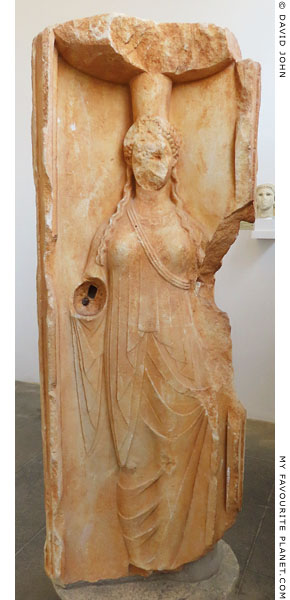
A Hekation, a trihedron in the form
of a tripod, Between each leg is an
incurving face with an Archaistic
relief of Hekate Triformis. She wears
a tall polos and a himation over
a long chiton.
Late Hellenistic period. Found near
the temple of Athena Polias on the
ancient acropolis of Rhodes.
Rhodes Archaeological Museum.
Inv. No. 5289. |
| |
| |
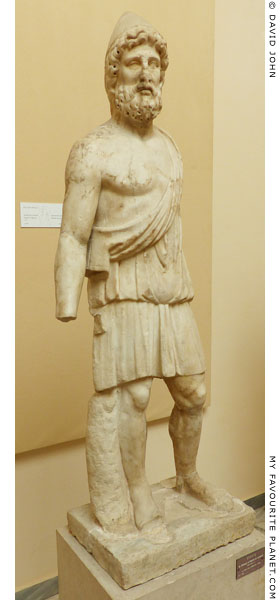 |
|
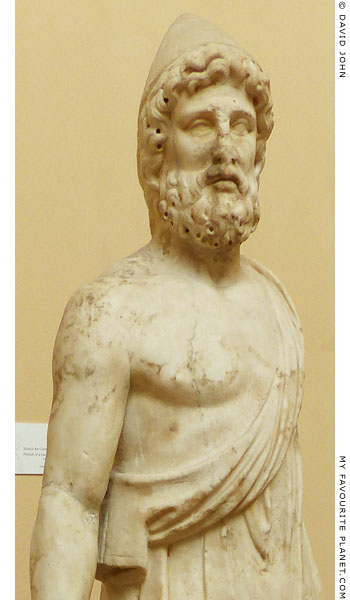 |
Marble statue identified as Vulcanus-Hephaistos.
Perhaps a copy of an original attributed to Alkamenes, 420-415 BC.
Found in the Baths of Mithras (Terme del Mitra, I,XVII,2), Ostia.
The statue lacks attributes, such as a hammer or axe, which would identify him
as Hephaistos. His pilos (conical cap, see Medusa) and short-sleeved chiton,
worn over one shoulder only, are reminiscent of depictions of Odysseus.
Ostia Archaeological Museum. Inv. No. 152. |
|
| |
Other works by Alkamenes mentioned by Pausanias:
A triple-bodied Hekate (known as Hekate Triformis), said to be the first of this type, which stood next to the Temple of Athena Nike on the Athens Acropolis.
"It was Alcamenes, in my opinion, who first made three images of Hecate attached to one another, a figure called by the Athenians Epipurgidia [Ἐπιπυργιδία, on the Tower]; it stands beside the temple of the Wingless Victory."
Pausanias, Description of Greece, Book 2, chapter 30, section 2. At Perseus Digital Library.
Due to the opinion stated by Pausanias, several extant depictions of triple Hekate ( see photo, above right) are believed to have been inspired by an original work by Alkamenes.
A cult statue of Hera in a temple of Hera between Phaleron and Athens. Pausanias wrote that the temple was reported to have been burnt by Mardonius in 480 BC, the general of Xerxes I during the second Persian invasion of Greece. For this reason it appears he doubted the claim that the statue was by Alkamenes. He may have believed that it was more recent and that Alkamenes worked before the Persian invasion.
"On the way from Phalerum to Athens there is a temple of Hera with neither doors nor roof. Men say that Mardonius, son of Gobryas, burnt it. But the image there today is, as report goes, the work of Alcamenes. So that this, at any rate, cannot have been damaged by the Persians."
Pausanias, Description of Greece, Book 1, chapter 1, section 5. At Perseus Digital Library.
A statue of Ares in the sanctuary of Ares in the Athens Agora. Pausanias did not say that it stood in the temple nor that it was the cult statue. If the cult statue inside the temple was by another artist, either he did not see it or did not find it noteworthy.
"Near the statue of Demosthenes [see Polyeuktos] is a sanctuary of Ares, where are placed two images of Aphrodite, one of Ares made by Alcamenes, and one of Athena made by a Parian of the name of Locrus [Λόκρος]. There is also an image of Enyo, made by the sons of Praxiteles [see Kephisodotos the Younger]."
Pausanias, Description of Greece, Book 1, chapter 8, section 4. At Perseus Digital Library.
A chryselephantine statue of Dionysos Eleutherios in the god's sanctuary next to the Theatre of Dionysos, Athens (Pausanias, Book 1, chapter 20, section 3).
A sculpture group of Prokne (Πρόκνη) and Itys (Ἴτυς), dedicated by Alkamenes, on the Athens Acropolis. This is among artworks Pausanias recommended to "those who prefer artistic workmanship to mere antiquity" (Pausanias, Book 1, chapter 24, section 3).
The west pediment at the rear of the Temple of Zeus at Olympia, with a depiction of the battle between the Lapiths and the Centaurs (a centauromachy, κενταυρομαχη).
"The sculptures in the front pediment are by Paeonius, who came from Mende in Thrace; those in the back pediment are by Alcamenes, a contemporary of Pheidias, ranking next after him for skill as a sculptor. What he carved on the pediment is the fight between the Lapithae and the Centaurs at the marriage of Peirithous.
In the center of the pediment is Peirithous. On one side of him is Eurytion, who has seized the wife of Peirithous, with Caeneus bringing help to Peirithous, and on the other side is Theseus defending himself against the Centaurs with an axe. One Centaur has seized a maid, another a boy in the prime of youth.
Alcamenes, I think, carved this scene, because he had learned from Homer's poem [Iliad, Book 13, line 389, and Book 16, line 482] that Peirithous was a son of Zeus, and because he knew that Theseus was a great grandson of Pelops."
Pausanias, Description of Greece, Book 5, chapter 10, section 8. At Perseus Digital Library.
Paionios of Mende may have made the sculptures on both pediments, while some scholars have considered on chronological and stylistic grounds that neither Paionios nor Alkamenes could have sculpted the pediments.
A statue of Asklepios for a temple at Mantineia in Arcadia, Peloponnese,
shared by the healing god and Apollo, Artemis and Leto (the "Apollonian Triad"; see Nike).
"The Mantineans possess a temple composed of two parts, being divided almost exactly at the middle by a wall. In one part of the temple is an image of Asclepius, made by Alcamenes; the other part is a sanctuary of Leto and her children [Apollo and Artemis], and their images were made by Praxiteles two generations after Alcamenes. On the pedestal of these are figures of Muses together with Marsyas playing the flute."
Pausanias, Description of Greece, Book 8, chapter 9, section 1. At Perseus Digital Library.
Alkamenes also made a colossal marble relief of Athena and Herakles, dedicated in 403 BC by Thrasyboulos in the temple of Herakles, Thebes, following the expulsion of the tyrants and the restoration of democracy in Athens at the end of the Peloponnesian War.
"Thrasybulus, son of Lycus, and the Athenians who with him put down the tyranny of the Thirty, set out from Thebes when they returned to Athens, and therefore they dedicated in the sanctuary of Heracles colossal figures of Athena and Heracles, carved by Alcamenes in relief out of Pentelic marble."
Pausanias, Description of Greece, Book 9, chapter 11, section 6. At Perseus Digital Library. |
|
|
| |
Pausanias also mentioned "a Hermes called Hermes of the Gateway" (Ἑρμῆν ὃν Προπύλαιον, Hermen on Propylaion) in front of the Propylaia of the Athens Acropolis.
"Right at the very entrance to the Acropolis are a Hermes (called Hermes of the Gateway) and figures of Graces, which tradition says were sculptured by Socrates, the son of Sophroniscus, who the Pythia testified was the wisest of men, a title she refused to Anacharsis, although he desired it and came to Delphi to win it."
Pausanias, Description of Greece, Book 1, chapter 22, section 8. At Perseus Digital Library.
An Archaistic marble herm of Hermes, discovered in Pergamon in 1903, bears the inscription:
"You will recognize the extremely beautiful statue by Alkamenes, the Hermes Before-the-Gate [Ἑρμᾶν τὸν Προπυλων, Herman ton Propylon]. Pergamios set it up.
Know thyself."
It was immediately concluded that this was a copy of the Hermes seen by Pausanias which by inference must have been by Alkamenes.
Another quite different marble herm of Hermes was unearthed in Ephesus in 1928, also with an inscription claiming it to be the work of Alkamenes.
See further information and photos on Pergamon gallery 2, page 15. |
|
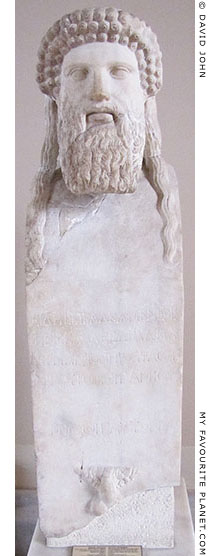
The Herm of Hermes from
Pergamon. "Copy of a herm
attributed to Alkamenes".
Roman period, thought to be
copy of a 5th century BC herm
attributed to Alkamenes.
Height 119.5 cm.
Istanbul Archaeological Museum.
Inv. No. 1433 T. Cat. Mendel 527. |
|
| |
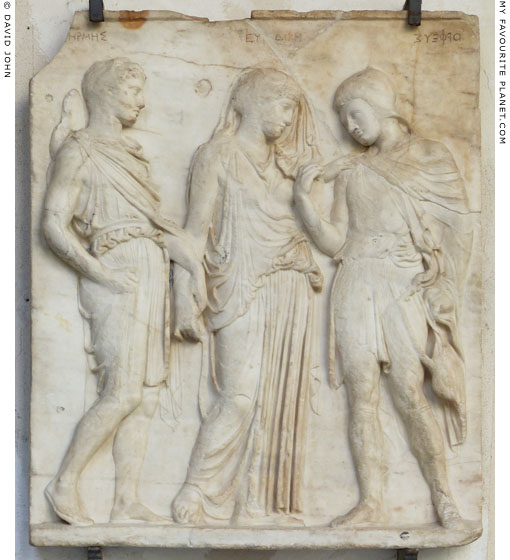
Marble relief, known as the "Orpheus Relief", depicting
Hermes, Eurydice and Orpheus in the Underworld.
Found at Torre del Greco, Bay of Naples. Height 118 cm, width 100 cm.
National Archaeological Museum, Naples. Inv. No. 6727. Carafa di Noja Collection.
|
The relief was made in 1st century AD, during the Augustan period, and before the eruption of Vesuvius in 79 AD. It is thought to be a copy of a Greek original of the second half of the 5th century BC, in the High Classical style of the sculptures of the Parthenon, and has been attributed to Alkamenes.
This is one of six almost identical surviving Roman period reliefs; two other almost complete examples are in the Villa Albani, Rome and the Louvre, Paris. The type is the earliest extant depiction of the well-known myth of Orpheus and Eurydice in the Underworld (Hades).
Distraught with grief by the death of his bride Eurydice, Orpheus descended to the Underworld in search of her. He charmed the gods there with his music and they permitted him to return with Eurydice to the land of the living, on the condition that he did not look back at her during the long journey back. However, when they had almost reached the boundary of the Underworld, Orpheus could not resist his longing to see her face. He turned and lifted her veil to look at her, breaking the condition set by the gods, and she was forced to remain in the realm of the dead.
In the relief Eurydice is shown unveiled, and she and Orpheus touch each other tenderly. But Hermes, as Psychopompos (Guide of Souls), has already taken hold of her arm to lead her back to her place among the dead.
The names of the figures are inscribed above their heads. Hermes is also identifiable by the petasos (broad-brimmed sun hat) hanging behind his head. The name of Orpheus, with his Phrygian cap and lyre, is written back-to-front, perhaps to indicate that he comes from the world of the living. |
|
|
| |
| Alkamenes |
Notes, references and links |
 |
|
1. Lemnos and Athens
Lemnos was taken some time between 515 and 495 BC by the Athenian Miltiades son of Kimon (Μιλτιάδης ὁ Κίμωνος, also referred to as Miltiades the Younger, circa 550-489 BC), who was then tyrant of the Thracian Chersonese, from the Pelasgians, the pre-Greek natives of Greece. Following the failure of the Ionian Revolt against the Persians (499-493 BC), Miltiades fled to Athens and gave Lemnos to the Athenians. He was appointed an Athenian general and was a hero of the Battle of Marathon in 490 BC. Although the island briefly fell into Persian hands around 509 BC, it was regained by Athens after the Persians had been driven out of the European side of the Nothern Aegean, Hellespont and Bosphorus, following the Greek victories at Salamis (480 BC) and Plataea (479 BC). See History of Stageira and Olympiada part 4. Whether the island was settled as a cleruchy or other type of colony, such as an apoikia (ἀποικία, literally, home away from home) remains a matter of debate.
See:
Herodotus, Histories, Book 5, chapters 26-27, and Book 6, chapters 136-140. At Perseus Digital Library.
J. A. S. Evans, Notes on Miltiades' capture of Lemnos. In: Classical Philology, Volume 58, No. 3 (July 1963), pages 168-170. The University of Chicago Press. At jstor.
A. J. Graham, The fifth century cleruchy on Lemnos. In: Collected papers on Greek colonization, chapter 16, pages 325-326. Brill, Leiden, Boston, Köln, 2001. Preview at Googlebooks.
Around 450-440 BC Pheidias made a bronze statue of Athena, known the "Athena Lemnia" (Λημνία) because it was dedicated on the Athenian Acropolis by the Lemnian colonists.
"There are two other offerings [on the Acropolis], a statue of Pericles, the son of Xanthippus, and the best worth seeing of the works of Pheidias, the statue of Athena called Lemnian after those who dedicated it."
Pausanias, Description of Greece, Book 1, chapter 28, section 2. At Perseus Digital Library. |
|
|
| Photos and articles © David John |
 |
Visit the My Favourite Planet Group on Facebook.
Join the group, write a message or comment,
post photos and videos, start a discussion... |
|
|
| |
|
|
| |
| |
 |
| |
 |
| |
 |
| |
 |
| |
 |
| |
 |
| |
George Alvanos
rooms in
Kavala's historic Panagia District
Anthemiou 35,
Kavala, Greece
kavalarooms.gr
|
| |
Olive Garden Restaurant
Kastellorizo,
Greece
+30 22460 49 109
kastellorizo.de
|
| |
Papoutsis
Travel Agency
Kastellorizo,
Greece
+30 22460 49 286
greeklodgings.gr
|
| |
|